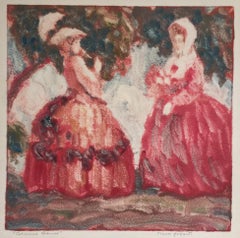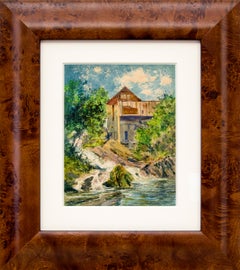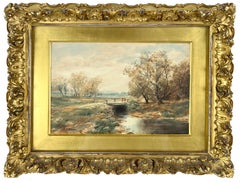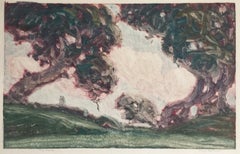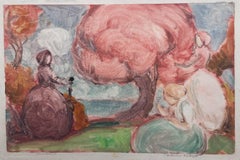Clark Hobart Art
American, 1868-1948
Clark Hobart was a painter and printmaker. He moved to California with his family when he was a small boy. Hobart was at the forefront of the American Monotype Movement in the teens. Hobart died in Napa, California, on February 23, 1948.
to
1
1
Overall Width
to
Overall Height
to
1
1
1
1
1
1
1
1
1
1
10,025
2,754
1,379
1,375
1
Artist: Clark Hobart
Colonial Dames
By Clark Hobart
Located in Santa Monica, CA
CLARK HOBART (1868 – 1948)
COLONIAL DAMES Monotype signed and titled in pencil
Hobart was an early 20 c. California painter. He was on the forefront ...
Category
1910s American Impressionist Clark Hobart Art
Materials
Monotype
$760 Sale Price
20% Off
Related Items
Charles Partridge Adams “New England Mill” c.1900 Original Watercolor Landscape
By Charles Partridge Adams
Located in Denver, CO
This circa 1900 original watercolor by renowned American landscape artist Charles Partridge Adams (1858–1942) captures a tranquil New England scene near Plainfield, New Hampshire. A ...
Category
20th Century American Impressionist Clark Hobart Art
Materials
Watercolor
$2,850
H 13.75 in W 12.25 in D 1.25 in
"A Shady Runlet" Stream in Fall New Jersey Watercolor 1878
Located in Soquel, CA
"A Shady Runlet" Stream in Fall New Jersey Watercolor 1878
A rare and exceptional watercolor of two ladies viewing a New Jersey stream in fall by William C. Bauer (American, 1856- 1...
Category
1870s American Impressionist Clark Hobart Art
Materials
Paper, Watercolor
$2,120 Sale Price
20% Off
H 13 in W 15.75 in D 1.38 in
Bright Idyllic Watercolor Landscape of a Lakeside Village with Canoeists
Located in Cirencester, Gloucestershire
Idyllic Watercolor Landscape
original watercolour painting on artist paper
signed by Marjorie Schiele (1913-2008) *see notes below
piece of paper is 9.5 x 12 inches
In good condition...
Category
Early 20th Century American Impressionist Clark Hobart Art
Materials
Watercolor
Canyon Country, 16x20, watercolor landscape, framed
By Lu Haskew
Located in Loveland, CO
Canyon Country by Lu Haskew
Pastel 16x20" image size
Additional images available upon request.
Landscape view of the Grand Canyon
ABOUT THE ARTIST: Lu Haskew 1921-2009
"Life is good to me. Being able to go to my studio five days weekly and paint for several hours, living in a supportive community, having family and friends who encourage me--all have contributed to helping me become an artist. Being fortunate to study with some of the artists I admire has kept me painting from the garden, people and my favorite things. With the support of galleries, teaching and doing demos, how could I do anything else? My goal is to try to be the best I can be by always being a student, looking for new ideas and stretching my horizons."
Upon retirement from a 33-year teaching career, Lu rented a studio in Loveland and began concentrating on
her oil and watercolor painting. Learning from artists she had followed and admired throughout the years
her painting became a full time career. Since 1992, she has studied with renowned painters Richard
Schmid, Clyde Aspevig, Joyce Pike, and others at the Scottsdale Art...
Category
1990s American Impressionist Clark Hobart Art
Materials
Watercolor
Vibrant Watercolor Landscape of a Sunlit Forest and Rolling Hills
Located in Cirencester, Gloucestershire
Vibrant Watercolor Landscape
original watercolour painting on artist paper
signed by Marjorie Schiele (1913-2008) *see notes below
piece of paper is 9.5 x 12.5 inches
In good conditi...
Category
Early 20th Century American Impressionist Clark Hobart Art
Materials
Watercolor
1888 George Elbert Burr Southwest Desert Landscape Drawing, Morning Near Arizona
By George Elbert Burr
Located in Denver, CO
This original 1888 color pencil drawing, Morning Near Arizona, is a luminous Southwestern landscape by acclaimed American artist George Elbert Burr (1859–1939). Rendered with Burr’s ...
Category
1880s American Impressionist Clark Hobart Art
Materials
Color Pencil
$1,590 Sale Price
40% Off
H 17 in W 20.25 in D 1 in
"Yesterday's Ladies" Figurative Drawing
By Virginia J Hughins
Located in Soquel, CA
Charming "Yesterday's Ladies" drawing by Aptos, California artist Virginia J Hughins,(Virginia Brubaker DeWolf), (American, 1923-2004). Presented in a rustic black wood frame. Signed...
Category
1990s American Impressionist Clark Hobart Art
Materials
Paper, Carbon Pencil
$440 Sale Price
20% Off
H 16 in W 19 in D 1 in
Preliminary Drawing for the color aquatint "New Orleans, Street Gossip"
By Louis Oscar Griffith
Located in Fairlawn, OH
Preliminary Drawing for the color aquatint "New Orlaens, Street Gossip"
Signed by the artist in pencil lower left
Graphite on tracing paper, 1916-1917
An impr...
Category
1910s American Impressionist Clark Hobart Art
Materials
Graphite
$1,500
H 9.38 in W 10.75 in
Big Sur Coast Landscape in Watercolor on Paper
By Paul Dougherty
Located in Soquel, CA
Big Sur Coast Landscape in Watercolor on Paper
Serene coastal landscape by notable artist Paul Dougherty (American, 1877-1947). The viewer looks out ov...
Category
Early 20th Century American Impressionist Clark Hobart Art
Materials
Paper, Watercolor
$1,480 Sale Price
20% Off
H 20.75 in W 26.5 in D 0.25 in
Rocky California Seascape in Watercolor on Paper
By Paul Dougherty
Located in Soquel, CA
Rocky California Seascape in Watercolor on Paper
Dramatic coastal landscape by notable artist Paul Dougherty (American, 1877-1947). Waves are churning ...
Category
Early 20th Century American Impressionist Clark Hobart Art
Materials
Paper, Watercolor
$1,480 Sale Price
20% Off
H 20.75 in W 26.5 in D 0.25 in
Untitled
Located in Fairlawn, OH
Untitled
Watercolor on paper, c,. 1890
Unsigned
Provenance: Estate of the artist
Image/Sheet size: 3 1/4 x 4 1/8 inches
From Wikipedia
"Francis Augustus Lathrop (June 22, 1849 – Oct...
Category
1890s American Impressionist Clark Hobart Art
Materials
Watercolor
Serene Cove Ripples, Mediterranean Seascape Diptych in Blue & White, Cyanotype
By Kind of Cyan
Located in Barcelona, ES
This is an exclusive handprinted limited edition cyanotype.
"Serene Cove Ripples" is a gorgeous original cyanotype diptych showing calming sea ripples in a Mediterranean cove.
Deta...
Category
2010s American Impressionist Clark Hobart Art
Materials
Lithograph
Previously Available Items
THE OAKS
By Clark Hobart
Located in Santa Monica, CA
CLARK HOBART (1868 - 1948)
THE OAKS c. 1915
Color Monotype titled and signed in pencil. 8” x 12 ¾” Full sheet, 10 3/8 x 14 3/4"
Hobart was an early 20 c. California painter. He ...
Category
1910s American Impressionist Clark Hobart Art
Materials
Monotype
AUTUMN FANTASY
By Clark Hobart
Located in Santa Monica, CA
CLARK HOBART (1868 – 1948)
AUTUMN FANTASY c 1915
Color monotype, 8 3/8” x 12 ¾”
Provenance: The San Francisco Museum of Art , with their lab...
Category
1910s American Impressionist Clark Hobart Art
Materials
Monotype
AUTUMN FANTASY
By Clark Hobart
Located in Santa Monica, CA
CLARK HOBART (1868 – 1948)
AUTUMN FANTASY c 1915
Color monotype 8 3/8” x 12 ¾”. Unique work thus! Excellent condition
Provenance: The San Fr...
Category
1910s American Impressionist Clark Hobart Art
Materials
Monotype
Clark Hobart art for sale on 1stDibs.
Find a wide variety of authentic Clark Hobart available for sale on 1stDibs. You can also browse by medium to find art by Clark Hobart in monotype and more. Much of the original work by this artist or collective was created during the 1910s and is mostly associated with the Impressionist style. Not every interior allows for large Clark Hobart, so small editions measuring 8 inches across are available. Customers who are interested in this artist might also find the work of Doris Warner, Arnold A. Grossman, and Edith Isaac-Rose. Clark Hobart prices can differ depending upon medium, time period and other attributes. On 1stDibs, the price for these items starts at $760 and tops out at $760, while the average work can sell for $760.
